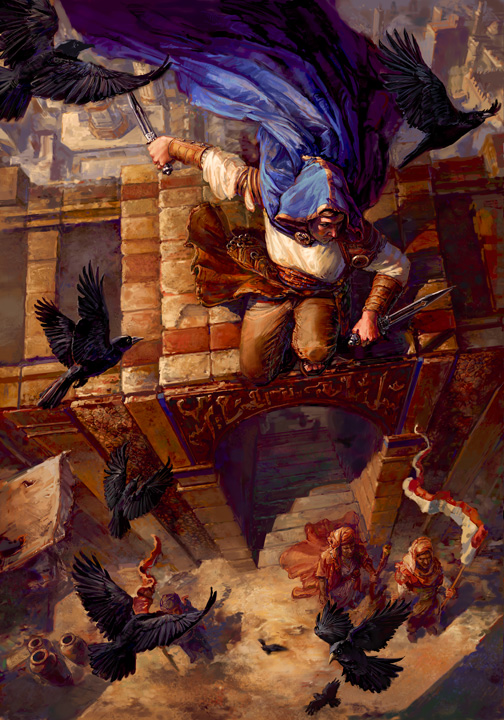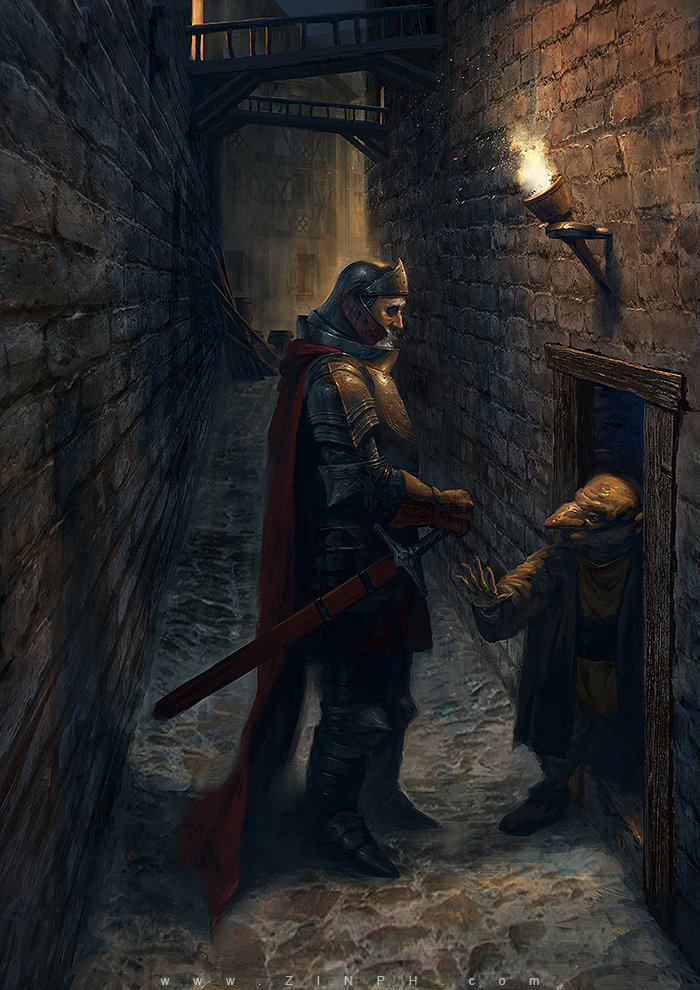You have 2:30 hours to infiltrate the gala, locate the papers secured behind a well guarded door in the host’s office. You must not be seen and no casualties should occur if possible. A carriage will be waiting for you in the backyard.
Everybody likes a
good heist, but it is often seen as something very difficult to accomplish in
D&D. Having heard that the new adventure Waterdeep: Dragon Heist didn’t
feature any actual heist, I thought I could design one myself. For these, I
rewatched some of the most well known heist movies and took notes from the ones
from GTA V (which are the ones I decided to take more from).
Time limit (optional)
Having a time limit
is more of a flavor thing as most things in a heist happen almost immediately or in few minutes.
However, it puts a sense of pressure in your players. Make them succeed at the
last second and you’ll see how they start cheering.
Having a map
(optional)
I’ve found out heists
work entirely different when players know every single detail about the
location than when they don’t. Do you want the PCs to investigate themselves
what they are looking for by making questions and following people from afar?
Or do you want them to have everything planned out from the start and know how
they need to move at the location in order to avoid guards? Consider starting
the heist at the beginning of the next game session to give the players time to
coordinate their movements if you are to choose the latter.
You may want to give
your players a flawed or incomplete map. That can also be fun, but be wary some players may not like it.
Having an inside man
(optional)
This is often used in
heist movies or games and adds some depth to the planning. You need to find
this person before achieving what you came to do. Why is that? Is this person
the only one who knows where the item to steal or target to assassinate is
located? Does he/she know of a secret code you must use? Is he/she supposed to
make a distraction for you to enter a building?
Another fun part
about having an inside man you must locate is to find a way to escort him/her
out of view from the other people who may be nearby. There are lots of ways you
can use this type of concept!
Guards
What’s the fun in a
heist if what you are looking for isn’t heavily guarded?
Place numerous guards
in specific places to control most of the place. Try to leave at least one
opening for your players to take advantage of. You can always inform the
players at which time the guards start patrolling or change places to help them
with their plan.
Consider having not
only normal guards, but also magic users and/or dogs if the place is guarding
something of utmost importance.
Locks
This is the things
for rogues to shine! (or magic users if a door is magically warded or locked).
Taking into account everything is located in a medieval fantasy, normally we
don’t have computers to hack into. This is replaced by having intricate locking
mechanisms and traps for the players to deactivate.
Reward the players
for waiting for someone to get in instead of just breaking into a place by
describing how that person deactivates the traps when they enter, or where they
hide the key when getting out from there.
A role for every
player
What I find to be the
best part about heists is that everyone is given a task that must be
accomplished for the plan to succeed. This mission doesn’t depend on only one
guy, but all the party (and maybe some npc to fill in some role). If one is to
fail everything could start getting wild.
Make sure as a DM to
have each of the players fulfill a specific task, and give everyone a time to
shine. Also, change the focus continuously during the heist for the players to
inform you what they are doing.
Generating a
distraction, getting the escape vehicle prepared, lockpicking closed doors, putting
guards to sleep, having a good view of the guards’ movements and gathering
information are just some of the roles your players could have. Establish this
beforehand to make all this more organized. A disorganized heist can become
frustrating very quickly.
Escape
The escape method will depend on how much
of a ruckus you make while fulfilling your tasks. If everyone moves super
stealthily and no one notices your presence, you may be able to get out from
the front door. However, escaping by ship, on carriage, on a flying carpet
waiting for you at the rooftops, or on a horse waiting for you outside, while
being chased for being discovered can also form part of the plan.


Complications
A plan can work
flawlessly, but where’s the fun in that? Failing in checks will make for most
of the complications you encounter. Maybe the rogue can’t get the door open. If
that’s the case, the barbarian can try breaking it down which can generate a
lot of noise. What if you need to throw a key from one corner of the room to
the other for a party member to catch it? If it were to fall, an alarm could be
triggered, and that’s where the fun and desperation begins.
Also, just like with
random encounters, make a table of things that could happen every time you
change focus between the player’s locations. Some examples are:
- A guard decides to go past the player’s location to get some water
- A guard forgot his weapon in another room and will go get it
- A cat shows by and starts meowing loudly
- Roomkeeping passes by the player’s location
- A person seems interested in the way you look or behave and starts a conversation
- A guest comes out from an unexpected place and notices you
- Someone decides to go for a smoke outside and walks past you
Your players may come
up with strange ways to infiltrate or deal with situations. Get ready to
improvise and create new complications on the spot if that was to happen.
Puzzles or secret
doors (optional)
Depending on the kind
of heist you planned out you can create a room with a puzzle or secret doors to
avoid certain locations. This type of things can happen if you infiltrate ruins
that are being guarded by cultists, or find a door that can only be opened by
solving a puzzle like the one from The Pacifier movie (making a puzzle code
based on a song is something that should be seen more often). Secret doors can
also be seen in mansions as sewer ducts, or ventilation systems (you don’t find
the latter very often in D&D though, for obvious reasons).
Communication
(optional)
In heist movies the
main characters are always communicated to a guy on a van waiting outside,
while also being able to talk to all the other ones who infiltrated the place.
If you like that sort of thing use Sending Stones or something like the
Critical Role’s homebrew Earrings of Whispers for the players to stay in
contact at all times. Try only giving one pair for them to split up
strategically from the beginning, or not giving any of these at all, to depend
on the plan they created before starting the heist.
Be generous
As always in D&D,
tip the scale to your player’s side, specially during a heist, as one little
mistake can collapse all their planning. Don’t force it very much though, as
trying to solve a situation on the spot creatively after failing at doing
something can make for some unforgettable moments. Also, reward creativeness
instead of punishing your players for thinking outside the box. Doing something
crazy may be more difficult to accomplish, but it’s not impossible. You want
this to be memorable, so let your players enjoy the moment.
Back to planning
tokens (optional)
I saw this done by
Mark Hulmes in a game he ran during the Stream of Many Eyes event held by
Wizards of the Coast to promote their new adventure. If you want to adjust the
difficulty of the heist consider giving 2 or 3 tokens of this kind to your
players. What does this mean?
Have you ever seen
those scenes in movies when the characters start following a plan during the
heist and the scene is cut to show the protagonists talking about how they
should deal with a situation they could encounter before it happens, to then
jump again to the other scene having the characters solving the problem just as
they planned?
That’s what we want to accomplish with the tokens. At any given moment during the heist, when the players deal with a situation they didn’t plan out, they can spend one of these tokens to pause the action for a moment, and talk freely as if they predicted these situation could happen (like a flashback from the planning part). When they are ready, go back to the heist and let them try what they planned out.
That’s what we want to accomplish with the tokens. At any given moment during the heist, when the players deal with a situation they didn’t plan out, they can spend one of these tokens to pause the action for a moment, and talk freely as if they predicted these situation could happen (like a flashback from the planning part). When they are ready, go back to the heist and let them try what they planned out.
I find it to be a
really original idea that can help make sure the players have a higher chance to succeed. And also freeze framing scenes is awesomely fun (both for players and DM).
Are you ready to run your swashbuckling heist? If you don't agree with one or more of my advices, or have some extra ones to give make sure to write them in the comments!



Comments
Post a Comment